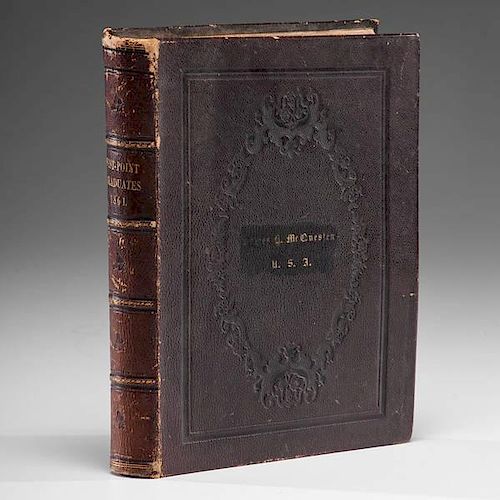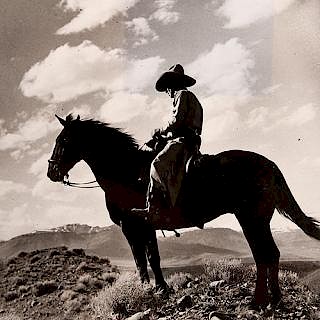West Point Year Book, Class of May 6, 1861
About Seller
6270 Este Ave.
Cincinnati , OH 45232
United States
With offices in Cincinnati, Cleveland and Denver, Cowan’s holds over 40 auctions each year, with annual sales exceeding $16M. We reach buyers around the globe, and take pride in our reputation for integrity, customer service and great results. A full-service house, Cowan’s Auctions specializes in Am...Read more
Two ways to bid:
- Leave a max absentee bid and the platform will bid on your behalf up to your maximum bid during the live auction.
- Bid live during the auction and your bids will be submitted real-time to the auctioneer.
Bid Increments
| Price | Bid Increment |
|---|---|
| $0 | $25 |
| $500 | $50 |
| $1,000 | $100 |
| $2,000 | $250 |
| $5,000 | $500 |
| $10,000 | $1,000 |
| $20,000 | $2,500 |
| $50,000 | $5,000 |
| $100,000 | $10,000 |
About Auction
Jun 12, 2015 - Jun 13, 2015
Cowan's Auctions dawnie@cowans.com
- Lot Description
Large octavo, 8.5 x 10 in., leather year book with gilt embossed boards and spine, cover identified to James McQuesten, U.S.A., spine embossed West-Point Graduates 1861, containing 57 oval albumen photographs, 5.25 x 7.25 in., mounted one per page, front and back, each divided by tissue guard, with most identified in pencil on mount by previous owner. Included are 11 photographs of various faculty members and 46 members of the May 6 graduating class. The year book also contains 2 photos of members of the June 1861 class: Justin Dimmick and Daniel Flagler.
At the beginning of 1861, West Point was in turmoil as was the rest of the United States. P.T.G. Beauregard of Louisiana had been appointed Superintendent of West Point, replacing Richard Delafield. Within a very short time Beauregard was relieved of his command when he made it known that if Louisiana seceded from the Union, he would approve. He was quickly replaced by Richard Delafield who again held the Superintendent’s post for two months until Alexander Hamilton Bowman replaced him.
The majority of the cadets were from the North, but there was representation of southern students, which created unrest on campus. On April 12, 1861, the Civil War officially began with the firing on Fort Sumter. One day later Secretary of War Edwin Stanton required all West Point cadets to take an oath of allegiance to the United States. Many students from southern states refused to do this and subsequently left campus.
Graduation was scheduled for June of 1861. However, President Lincoln’s need for trained soldiers in the Union army was so high that the event was moved to May 6, 1861. At this time, 45 students graduated, minus one who deserted before the actual graduation.
Training was intensified so that the class that was to have graduated in June of 1862 actually finished their work in two months and a second commencement was held in June of 1861. Thirty-four cadets were included in this group, including George Armstrong Custer who was at the very bottom of his class.
Among the instructors, John F. Reynolds is pictured in the album. Reynolds was one of the Union Army's most respected senior commanders, and he played a key role in committing the Army of the Potomac to the Battle of Gettysburg; however, he was killed at the start of the battle.
The following cadets are pictured in the album and are listed here in order of their class rank. Indicated following the name is whether the graduate served in the Union Army (U) or in the Confederate Army (C). An asterisk indicates the soldier was killed in the Civil War:
Henry A. Du Pont (U), Charles E. Cross (U* Fredericksburg), Orville E. Babcock (U), Henry W. Kingsbury (U*Antietam), Adelbert Ames (U), Llewellyn G. Hoxton (C), Albert R. Buffington (U), Emory Upton (U), Nathaniel R. Chambliss (C), Edmund Kirby (U*Chancellorsville), John I. Rodgers (U), Samuel N. Benjamin (U), John Adair (deserted), John W. Barlow (U), Charles E. Hazlett (U*Gettysburg), Charles E. Patterson (C*Shiloh), Judson Kilpatrick (U), Franklin Harwood (U), George W. Dresser (U), Charles McK. Leoser (U), Henry C. Hasbrouck (U), William A. Elderkin (U), Francis A. Davies (U), Charles C. Campbell (C), Malbone F. Watson (U), John B. Williams (U), Guy V. Henry (U), Jacob H. Smyser (U), Jacob B. Rawles (U), Erskine Gittings (U), J. Ford Kent (U), Eugene B. Beaumont (U), Leonard Martin (U), John S. Poland (U), Robert L. Eastman (U), Henry B. Noble (U), Leroy L. Janes (U), Campbell D. Emory (U), James F. McQuesten (U*Opequon, VA), George O. Sokalski (U), Olin F. Rice (C*Opequon, VA), Wright Rives (U), Charles H. Gibson (U), Mathias W. Henry (C), and Sheldon Sturgeon (U).
Eight of these cadets graduating In May of 1861 returned to West Point in some capacity during their careers, either to teach or to take administrative positions. Several entered the field of politics: Adelbert Ames became a governor and then a senator from Mississippi after Reconstruction. Others became businessmen; the most notable being Henry A. Du Pont who returned to Delaware after the War to run his family’s company. Some spent their entire careers in the military, as engineers, artillery men, and moving on to the western frontier after the Civil War.
Five of the graduates received the Medal of Honor for their service in the Civil War: Henry A. Du Pont, Guy V. Henry, Eugene B. Beaumont, Adelbert Ames, and Samuel Benjamin.Wear to binding, especially along spine, some loss to embossed gilt details, including loss to first name of album's original owner, "James." Album's inside boards and free front and back papers show spotting, staining. Photographs remain in very good to near excellent condition overall, retaining nice, rich tones. Album pages do show some light, scattered spotting. Previous owner penciled name of each subject on mount, near top right corner.Condition
- Shipping Info
-
SHIPPING. At the request of the buyer, Cowan's will authorize the shipment of purchased items. Shipments usually occur within two weeks after payment has been received. Shipment is generally made via UPS Ground service. Unless buyer gives special instructions, the shipping method shall be at the sole discretion of Cowan's Auctions, Inc.. Cowan's is in no way responsible for the acts or omissions of independent handlers, packers or shippers of purchased items or for any loss, damage or delay from the packing or shipping of any property.
-
- Buyer's Premium



 EUR
EUR CAD
CAD AUD
AUD GBP
GBP MXN
MXN HKD
HKD CNY
CNY MYR
MYR SEK
SEK SGD
SGD CHF
CHF THB
THB


















